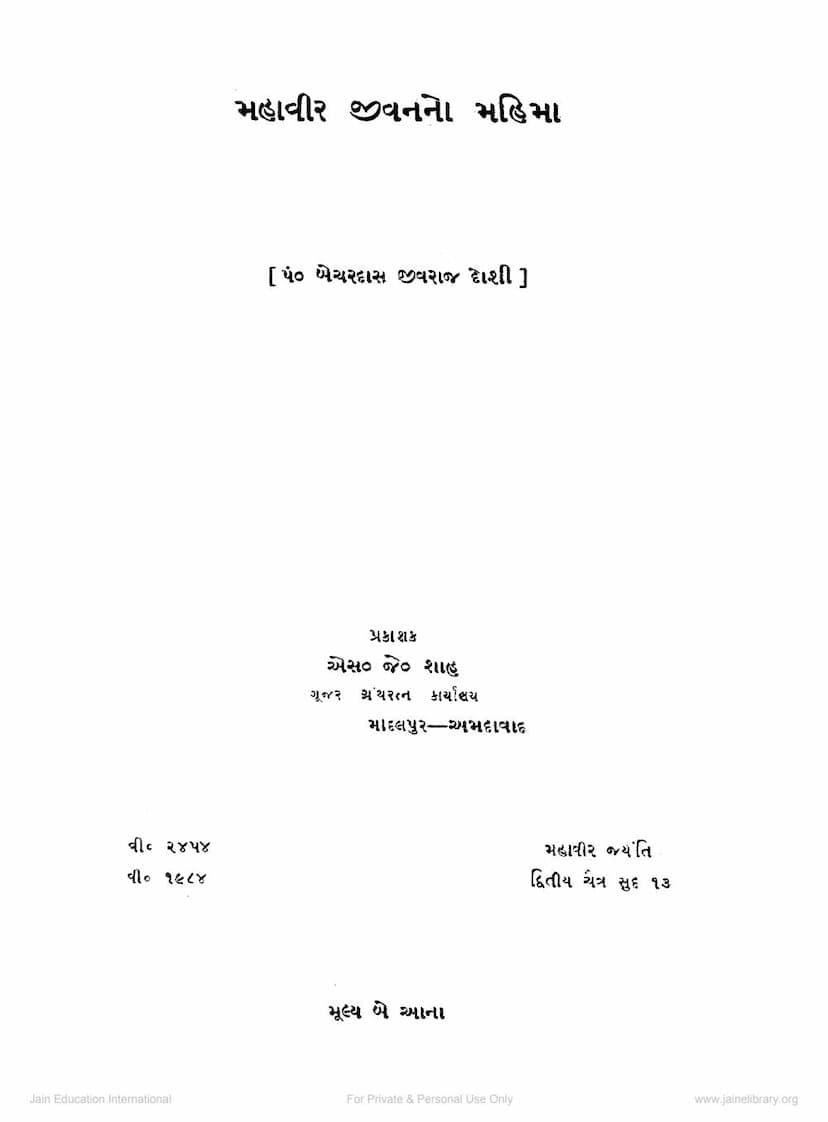Mahavira Jivanno Mahima
Added to library: September 2, 2025

Summary
Here's a comprehensive summary of the provided Jain text, "Mahavira Jivanno Mahima" by Bechardas Doshi, based on the pages you've shared:
Title: Mahavira Jivanno Mahima (The Glory of Mahavira's Life) Author: Bechardas Doshi Publisher: Gurjar Granthratna Karyalay Publication Year: V.S. 1984 (1927 CE) Occasion: Mahavir Jayanti, Chaitra Sud 13
This book, "Mahavira Jivanno Mahima," is a detailed exploration of the life and teachings of Lord Mahavira, the 24th Tirthankara of Jainism. The author, Bechardas Doshi, aims to present a comprehensive and inspiring account that goes beyond traditional hagiography, incorporating a scholarly approach.
Author's Intent and Approach:
- Desire to Illuminate: The author expresses that many friends have urged him to write about Mahavira's life, acknowledging the difficulty of the task.
- Scholarly Rigor: Doshi emphasizes that writing about Mahavira requires not just devotion but also a deep study of Jain Agamas, Buddhist Tripitaka, Upanishads, and other ancient Indian literature. He believes that simply retelling traditional stories is insufficient; a scientific and well-researched approach is necessary.
- Internal and External Requirements for Biographers:
- Internal: Sincere devotion, faith, wisdom (intellect), equanimity (even-mindedness), and memory are essential. These qualities need to be balanced like humors in the body for accurate representation.
- External: Extensive study of various scriptures, history, philosophy, geography, linguistics, and comparative religion is crucial.
- Addressing the Need for a Modern Biography: The author notes that while many Jain biographies of Mahavira exist in various languages, there's a need for a work that addresses the expectations of the contemporary reader, which often leans towards historical and social context.
- Comparison with Buddhist Narratives: A significant portion of the text (pages 4-6) focuses on comparing the birth and life events of Mahavira with those of Lord Buddha as described in texts like "Lalitavistara." Doshi highlights striking similarities in the descriptions of auspicious signs, divine interventions, and the birth itself, suggesting a common cultural and religious narrative tradition. He provides parallel quotes from the Kalpasutra (Jain) and Lalitavistara (Buddhist) to illustrate these parallels.
Key Areas of Study and Content:
The book outlines a vast scope of required knowledge for a comprehensive biography of Mahavira. This includes:
- Jain Scriptures: Thorough study of original Agamas, Niryuktis, Bhashyas, Churnis, Avachurnis, and their commentaries.
- Jain Philosophy and Doctrine: In-depth understanding of Ahimsa (non-violence) and Anekantavada (multi-sidedness).
- Jain Sects and History: Knowledge of both Svetambara and Digambara traditions, their historical development, and their specific doctrines.
- Concept of Heaven and Hell: Detailed study of the Jain cosmology regarding svarga (heaven) and naraka (hell) as described in both branches of Jainism and other religions.
- Social and Societal Context: Understanding of social structures derived from Jain Sutras, and the lives of important Jain Acharyas.
- Comparative Religious Studies:
- Study of the Vedic and Aryan traditions, including Vedas, Vedangas, Upanishads, Mahabharata, Puranas, Smritis, Grihya Sutras, Kalpa Sutras, and Shrauta Sutras.
- Examination of Brahmanical and Aranyakas.
- Study of Buddhism, including Pali Tripitaka and Mahayana texts.
- Study of other religions like Islam (Quran), Zoroastrianism (Avesta), and Christianity (Bible).
- Geographical and Astronomical Knowledge: Familiarity with the geography and astronomy as understood in ancient India, both from a mythological and scientific perspective.
- Linguistic Studies: Understanding of ancient Indian languages and grammar.
- Biographies of Other Great Souls: Studying the lives of other significant religious figures like Buddha, Krishna, etc., to avoid bias and ensure fairness.
Examples of Comparative Narratives (Buddha vs. Mahavira):
- Birthplace and Lineage: Both Mahavira and Buddha are depicted as being born into noble Kshatriya or Brahmin families, not in lower strata of society, signifying their elevated status.
- Celestial Events at Birth: The texts describe similar auspicious signs at the time of their births, such as pleasant weather, melodious sounds, divine light, and celestial gatherings, indicating the birth of a great soul.
- Divine Interventions: Both narratives mention divine beings attending to the mother and the newborn, with processions and offerings. The description of directional deities (Dikumaris) and their offerings during Mahavira's birth is detailed.
- Miraculous Occurrences: Similar descriptions of miraculous events, like the auspicious lotus appearing beneath the feet of the newborn, are found in both traditions.
The Author's Call to Action:
Doshi concludes by urging monastic scholars (Munigans) to undertake this monumental task of compiling a definitive biography of Mahavira. He believes that a collaborative effort, perhaps through a series called "Mahavircharitra Sadhan Sangrahavali," involving various experts, would lead to a truly comprehensive and influential work. He feels it's essential to present the objective historical realities alongside the poetic and faith-driven elements to provide a balanced understanding for the readers.
In essence, "Mahavira Jivanno Mahima" is presented as a call for a scholarly yet devotional approach to understanding the life of Lord Mahavira, emphasizing the need for extensive research, comparative analysis, and a commitment to truth and inspiration.